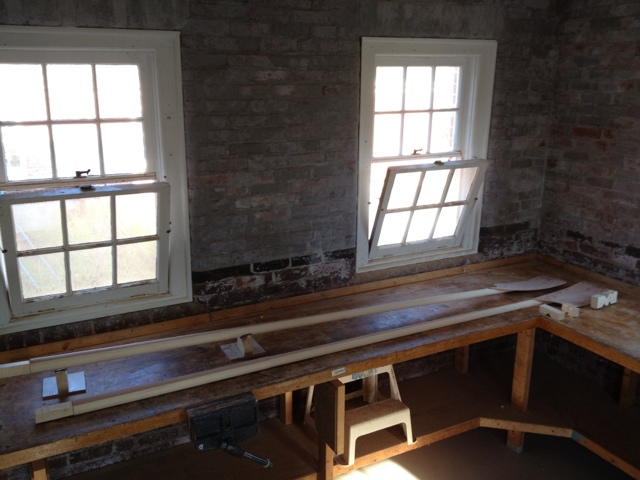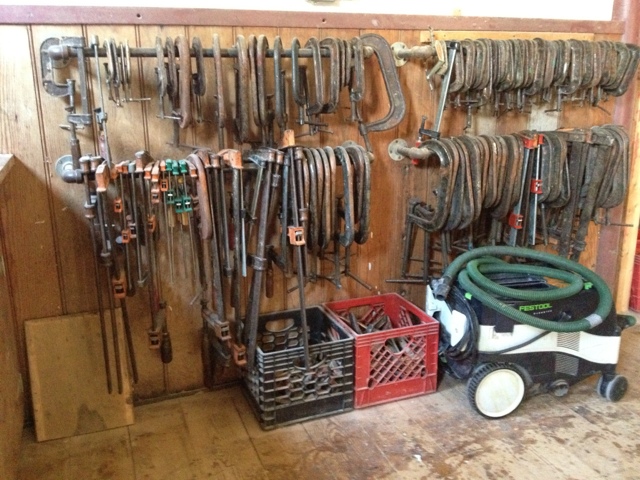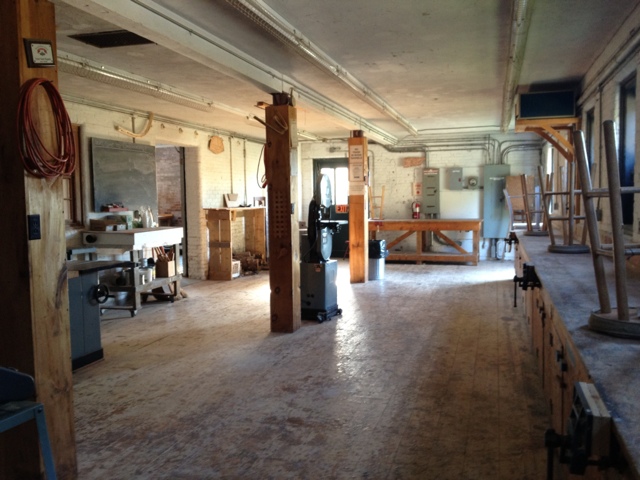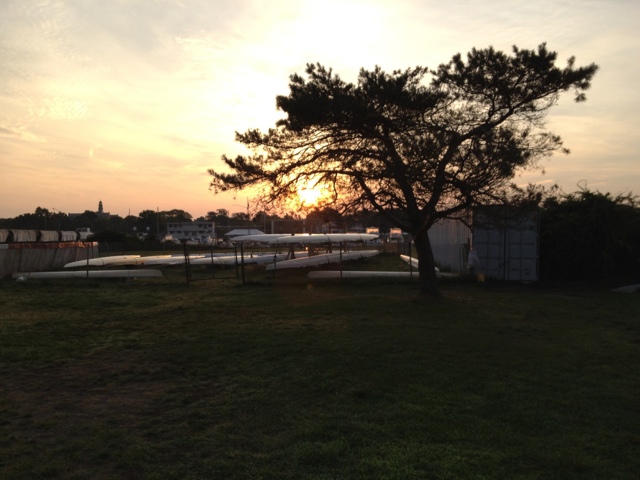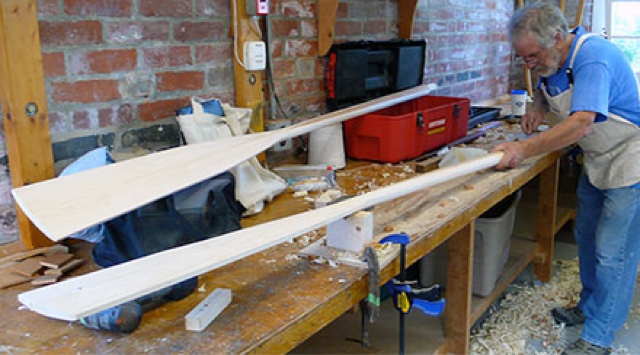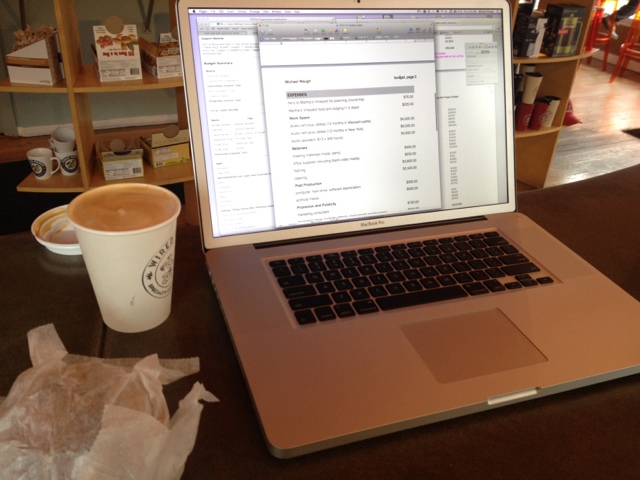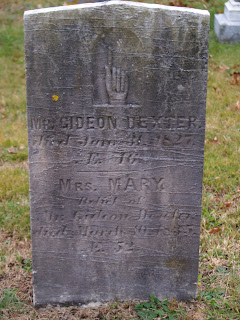In 1827, my great-great-great-great grandfather froze to death in a rowboat on Buzzards Bay. I'm preparing to go to the spot where he was found and then row the 25 miles back to my family's home town.
Friday, December 21, 2012
Queer Erg
Once again, I am working in overdrive, having set myself a crazy deadline. The prequel show of work related to my rowing back project is due to open in 22 days, on January 12. Since the biggest project still remaining to finish is video, and video is notoriously apt to have unforeseen technical issues, and the holidays are going to slow me down, I probably have seven days to work. Okay, I need to breathe.
I have all the video clips imported, and I have them roughly placed. But none of them are in sync with the sound. I haven't figured out the timing. And I need to reduce one clip that is an hour long to 5 minutes.
The hour long clip is footage of me using a rowing machine (an erg) at the YMCA, working on developing the stamina that I'll need for my big row. The hour wore me out. But the footage is kind of great. I mounted my camera on the handle of the machine, so I am constantly pushing the camera away from myself -- and then pulling it up to my chest. The wide-angle of the lens makes my chest swell to womanish proportions with every stroke. It's good, old-fashioned queering. And it helps to add dimension to the drawings in the show that have the most obvious queer content (such as the two crew-lovers in Restraint on Competition).
Tomorrow I'm packing up my computer and my editing drive and flying with them to my sister's house in Texas for a holiday with my family. I hope I can de-stress enough to be good company!
Saturday, December 01, 2012
Sippican Week: Artist Michael Waugh submerged in 2-year project
By Georgia Sparling | Nov 29, 2012
MATTAPOISETT — Hopping into a narrow boat you’re almost sure to capsize in 55-degree water is an unusual way to connect with your ancestors.
But Michael Waugh’s project is anything but run of the mill. The Brooklyn-based artist, who also spends time in Mattapoisett, began a two-year rowing project earlier this summer to retrace the final hours of his great-great-great-great grandfather Gideon Dexter.
Dexter was killed on January 31, 1827 when he rowed into Buzzards Bay trying to save his employer’s runaway skiff. The following morning, he was found frozen on Martha’s Vineyard.
“This very tragic, personal story, has a larger economic truth to it, too,” said Waugh. “Working class people take risks that other people don’t.”
With his project, Waugh will retrace Dexter’s trip in reverse – rowing from Martha’s Vineyard to Mattapoisett with a boat and oars of his own making
The performance artist, who began rowing lessons this summer, launched a boat into New Bedford Harbor on Monday to document his progress.
“I’m a visual artist. In order to document and communicate visually where I’m at with this project, I needed to do the performance.”
Waugh used oars he engraved with excerpts from Adam Smith’s “The Wealth of Nations,” considered the first modern work on economics, and “The Theory of Moral Sentiments,” a book on morality and society.
Of his launch, Waugh said, “In essence, this is to illustrate where I’m starting and how the right equipment matters.”
Still a novice, Waugh said he wouldn’t be surprised if he got wet. “It’s like being on a tight rope. You have to keep the oars level or you just go over.”
With help from New Bedford Community Rowing Program Director Cheyenne Bayse and other members, Waugh climbed into the wobbly boat and was pushed away from the dock.
Once in the water, Waugh found the narrow boat difficult to balance, and tipped over a few feet from the dock.
“Today’s footage really communicates clearly my level of experience,” he said. “Today also lit a fire under me, driving home what I still need to do.”
Waugh will help raise funds for his project through a show in New York City in January.
Originally published in Sippican Week. Photos and video by Georgia Sparling.
MATTAPOISETT — Hopping into a narrow boat you’re almost sure to capsize in 55-degree water is an unusual way to connect with your ancestors.
But Michael Waugh’s project is anything but run of the mill. The Brooklyn-based artist, who also spends time in Mattapoisett, began a two-year rowing project earlier this summer to retrace the final hours of his great-great-great-great grandfather Gideon Dexter.
Dexter was killed on January 31, 1827 when he rowed into Buzzards Bay trying to save his employer’s runaway skiff. The following morning, he was found frozen on Martha’s Vineyard.
“This very tragic, personal story, has a larger economic truth to it, too,” said Waugh. “Working class people take risks that other people don’t.”
With his project, Waugh will retrace Dexter’s trip in reverse – rowing from Martha’s Vineyard to Mattapoisett with a boat and oars of his own making
The performance artist, who began rowing lessons this summer, launched a boat into New Bedford Harbor on Monday to document his progress.
“I’m a visual artist. In order to document and communicate visually where I’m at with this project, I needed to do the performance.”
Waugh used oars he engraved with excerpts from Adam Smith’s “The Wealth of Nations,” considered the first modern work on economics, and “The Theory of Moral Sentiments,” a book on morality and society.
Of his launch, Waugh said, “In essence, this is to illustrate where I’m starting and how the right equipment matters.”
Still a novice, Waugh said he wouldn’t be surprised if he got wet. “It’s like being on a tight rope. You have to keep the oars level or you just go over.”
With help from New Bedford Community Rowing Program Director Cheyenne Bayse and other members, Waugh climbed into the wobbly boat and was pushed away from the dock.
Once in the water, Waugh found the narrow boat difficult to balance, and tipped over a few feet from the dock.
“Today’s footage really communicates clearly my level of experience,” he said. “Today also lit a fire under me, driving home what I still need to do.”
Waugh will help raise funds for his project through a show in New York City in January.
Originally published in Sippican Week. Photos and video by Georgia Sparling.
Monday, November 26, 2012
The Shortest Voyage
Last Friday, I finished burning text onto the oars that I started making last August. They're beautiful -- and, perhaps, useful. Over the weekend, they got a single coat of varnish. That's not enough for a long voyage. But I had nothing to worry about.
I decided to christen the oars today by attempting to row a racing shell. I tried this once before, with similar results. So I wasn't expecting to get far -- and didn't. About ten seconds into the voyage, it ended. Weather report: the water in New Bedford Harbor is currently 55 degrees. I am glad that I decided to make this attempt today. My original idea was to do it on January 31, the anniversary of Gideon Dexter's death (the event around which this whole project revolves).
I need to thank the four people who helped me today: Cheyenne Bayse, Carolyn Flynn, Sheilagh Flynn, and Calder Reardon. All the boats had been stored for the winter, so preparing for today's row and the safety precautions necessitated by the chilly water were not simple. Of course, I need to thank also New Bedford Community Rowing -- and assure all readers that novice rowers are not encouraged to get into elite boats like this. I was indulged because I wanted to experience exactly how far I have to go in learning and preparing for my row. I only got about 20 feet from the dock. So my question has been answered.
Friday, November 16, 2012
Practicality
Most of the difficulty involved with this project is personally rewarding. I like learning about Buzzards Bay, learning to row, and making art. But two aspects are not: fundraising and marketing.
One of the things that I decided early on is that I would develop an interim show that would exist as a kind of prequel to my rowing project. And that show is slated to happen this January. The show uses rowing imagery and text related to economics. The show will be hosted at Winkleman Gallery in collaboration with my long term gallery, Schroeder Romero.
The show stands on its own. But because the work relates to the ongoing rowing project, the January show will give me the perfect opportunity to talk about what's next. On a more practical level, the January show also will give my dealers the opportunity to sell some drawings. I'm keeping my fingers crossed that they will sell enough to subsidize the larger goals that I have over the next year and a half. I have, of course, applied for several grants that could help support this project. But, so far, I've received two rejections. So I'm not going to stake my career on the lottery of grants.
Over the past few days, I've been working on a design for a catalog of the drawings that will be in the January show. It's a handsome book. I can send it out to potential funders or to potential curators. But it's also available to order online. So I could possibly sell a few copies and make a few dollars to support this project. I'm planning to print and set aside 25 copies of this catalog. I'll sign and number them and offer them as premiums for contributors who donate to a kickstarter campaign. I plan to launch that during my January show, too. I'm certainly not going to start it now. There are too many people in need right now in New York. Winkleman Gallery, for example, was devastated. And I'd be remiss if I didn't mention the practicality of rebuilding the gallery before I can have a show in it. Hurricane Sandy relief is the immediate, practical problem.
If you're curious about the catalog, you can visit lulu.com. It could make a nice holiday present for someone -- but support Sandy relief first.

Wednesday, November 07, 2012
Prequel Images
I finally have professional images of the drawings that will be part of my upcoming show. I've posted the whole series on my web site. The largest drawing, a triptych, is 84" tall and each panel is 42" wide. When framed and hanging, it spans about 12' of wall. As with my other large drawings, it is overwhelming in person, but the detail gets lost in a JPG. Here's a detail:
The first ten drawings in this series, portraits of Ivy League rowers, were part of my 2011 show at Schroeder Romero. I followed those portraits by making seven modestly-sized landscapes, the triptych, and then two more portraits. All of the drawings use rowing as subject matter. Like my previous drawings, these pieces use micrographic text to compose the images. The series uses the entirety of Adam Smith's *The Wealth of Nations.* All told, I copied by hand 507 pages of text. The largest, the triptych, used 265 pages of text:
I think of this large work as the anchor of the series. It shows the image of a steamship getting subsumed by a storm at sea. A single passenger, a woman, stands on deck, hands clasped, looking out for rescue. A single sculler rows towards the doomed ship.
Adam Smith's book is something of a Bible for economic conservatives. Smith famously refers to the economy as being guided by an "invisible hand." However, like the Bible, the text is vast -- so vast that it seems, at times, to contradict itself. In addition to arguing for the virtues of self-interest, Smith also notes that governments should probably not allow businessmen to guide legislation. Although he hails the division of labor as the cause of wealth, he also notes that it has dehumanized workers and led to moral degradation. His book is speculative, not necessarily prescriptive.
I have engaged with rowing imagery for a number of reasons. One of the most basic is that crew, in addition to being a favorite art historical subject, also brings with it an undeniable mark of class privilege. In 1776, when Smith published the book, notions of class were unformed. And crew isn't the only sport that announces the privilege of its participants; all sport takes skills developed for the purpose of survival and transforms those skills into autonomous activity. The first marathoner, Pheidippides, ran 26 miles to announce to Athens that the Persians had been defeated -- not to achieve a personal best.
The transition of boating from a necessary skill for fishing and transportation into a sport is neither simple nor is it clearly an evolutionary improvement. Sport in itself calls into question the idea of progress. The Wealth of Nations continually makes the case for modern economic systems being more evolved than what came before, even though Smith cites problems with that narrative.
It struck me while reading The Wealth of Nations that so much of what is foundational for modern economic theory is also foundational for scientific theory and for art theory -- and are recurring questions in our own lives. Finding meaning is never as straightforward as it first appears. How can one summarize the visceral experience of making these drawings, of copying a 507 page book, of standing in front of the record of that much labour.
Friday, November 02, 2012
Water Everywhere
Superstorm Sandy has put a pre-mature end to this year's on-water rowing practice. I shot the above video a couple of weeks before the storm hit. And I'd hoped to get out there some more. I only got to row a single twice. The video is of my second time sculling. I'm pretty rough. I don't hold the oars even. I can't feather them. I haven't figured out how to get even power. But it was a beautiful day and I rowed the perimeter of New Bedford Harbor, which took about an hour (rowing inside the hurricane barrier and excluding the superfund, clean-up site).
Last week, I wrote on this blog that I would post photos of my recently completed large drawing. I should have been in New York during Sandy getting the drawing photographed. Instead, I stayed up in Massachusetts to help keep watch on my mom's house. I did have to get up on a barn roof during the hurricane and staple down a strip of roofing that blew off. But, otherwise, things were pretty light.
At New Bedford Community Rowing, all the boats were taken off their outdoor rack, shrink wrapped, and staked to the ground. Today, I went over to help unwrap some and re-rig them. Unfortunately, the single that I rowed in the video seems to have been taken off site, stowed away for the winter. So I may have to wait until next Spring to work on my technique.
I'll be heading home to Brooklyn Sunday or Monday so that I can vote on Tuesday. And I hope to get my work Photographed soon. I'll also get a chance to help my friends who've been effected by the storm. I fear that at least one of my drawings was destroyed by Sandy*; it was at the gallery where my January show is scheduled. The gallery suffered heavy flooding -- Kind of ironic considering that the two central pieces of that show will (hopefully!) be 1) a drawing of a ship getting subsumed by a storm -- and 2) the pair of wooden oars that I've been working on since August. Oars aren't much use against a storm, especially without a boat.
(* update 11/4/12: the drawing survived!)
Monday, October 22, 2012
Watershed Ride
On Sunday, the 14th, I participated in the Buzzard Bay Coalition's annual fundraising ride, in which "A record 147 cyclists raise[d] a projected $68,000 for clean water." The route took us through the watershed that empties into the bay, from Horseneck Beach in Westport to Quissett Harbor in Falmouth.
I had ridden most of the roads before -- but not all at once. A ride like this creates a strong link between the idea of the bay and the physical experience of space. So, for my project, the experience was invaluable -- especially undertaking it with so many other people who care about the health of the water.
I raised $300 from eleven donors. Of course, anyone can still donate to the coalition on my ride page. I personally have benefitted from the organization through experiences like this ride and from volunteering on the coalition's water monitoring boat. I need to acquire local knowledge about the bay for my project. The coalition's main offices also provides educational programs about Buzzards Bay. An interesting fact is that the largest contributor to pollution in the bay is the nitrogen that gets into the watershed from individual septic systems throughout the area which we cycled -- not golf courses, not cars, not boats. The biggest problem is the sheer number of people whose toilets are not connected to the grid.
I video recorded the whole ride and have posted the documentation below. It's sped up 1000%, so the four hours and fourty minutes that I was cycling are condensed into less than twenty minutes. It provides a nice portrait of the region.
Sunday, September 02, 2012
Oars
I just got back from Brooklin, Maine and the Wooden Boat School. I took a class from oar-maker Clint Chase, who was able to communicate a his craft clearly, patiently and with deep knowledge. If you've ever thought about building your own boat or learning to row or sail, this school is amazing, and I can't recommend it enough.
I haven't ever done any fine woodworking before, so there was a huge learning curve -- as there is with almost every aspect of this project. The woodworking that I'd done before, I did as a kid with my dad. My family had a really nice group of shop equipment that had been in my mom's family: a band saw, a fixed jig-saw, a drill press ... I think there was a planer too, but I never saw my dad use it. He wouldn't have needed it because he never did precision woodwork. We built utility shelves and small, practical things like that.
I spent a lot of time during the week thinking about my dad. Ostensibly, my project centers around the story of the death of my great-great-great-great grandfather on my mother's side of the family. But the emotional core of the project really resides with the loss of my own father. And working in a shop, relearning how to use the power equipment really drove this point home for me. It was an emotional week.
Getting outside of one's usual routines, of course, encourages such woolgathering --but even more so in a school environment, which is always a bit abstracted from reality. The Wooden Boat School, situated off of a stunning cove along the Maine coast is highly abstracted from my daily routine.
The cliché about attending school is that most of the learning takes place outside the classroom. On a practical level, this was not the case. I learned an immense amount in class about wood and tools and equipment and oar design and shop maintenance and pedagogy etc. And I spend about 10 hours each day in the shop working.
However, my time at the school outside the shop did raise a lot of issues that run throughout this project. The craft of building oars and boats and of sailing and kayaking and rowing -- all of the things taught at the school -- are practical crafts that were developed out of necessity. But they exist now in a rarified atmosphere -- supported as leisure activity and as art. There is nothing wrong with leisure or art, as such. But the transition away from necessity is striking -- and the bulk of the conversations at the school reinforced the aestheticized nature of the activities.
The same transformation exists in rowing, in the transition from practical skill to sport. And the transformation exists in the environmental work regarding Buzzards Bay, which seems to spread its environmental message most effectively among people that use the bay for leisure activity.
These are all threads that fascinate me as I continue my research and consider the changes that have taken place around Buzzards Bay since 1827. But, it's also nice to not just be soaking in these serious issues of loss and economic transformation. I have something other than just abstract ideas from my scholastic week. I have a great set of sculling oars.
Saturday, August 25, 2012
Sunrise Training
It was a perfect morning today for my first training session with New Bedford Community Rowing. We went out in a 4 (4 person boat), since there weren't enough people for an 8.
I'm beginning to realize that my 20 mile trip isn't really going to be a big deal. It seemed extreme when I first started thinking about rowing from Martha's Vineyard to Mattapoisett. I've only ever crossed Buzzards Bay in a huge ferry.
But this morning, we rowed several miles. Sure, it was exhausting. Sure, I ripped the skin off of two fingers and reopened Wednesday's blisters. But it was only my 6th time out on the water.
The coach this morning told me about a 25 mile race up the Hudson. My 20 miles is not outrageous.
When I first started cycling, I thought 25 miles was long. Now I can ride the one-day, 210 mile trip from Brooklyn to Massachusetts.
The harder part of this trip will be getting a crew together to help me with the row and with documenting it. I'm used to doing everything myself. But, of course, this need for cooperation is what this project is about. Gideon Dexter died trying to row by himself. Rowing crew is a group effort. Working as part of a team is outside the skill-set of most artists.
Thursday, August 23, 2012
Protection
This week marked the third and final week of my introduction to rowing class with New Bedford Community Rowing. I'll post a little footage soon, but I didn't shoot as much as I'd hoped. My (unfulfilled) plan had been to put my camera in an underwater case to protect it from splashes and salt-water spray. The SNAFU in that plan is that Sony, about a year ago, stopped making the case made for my camera.
So I've been trolling the Internet for months looking for the discontinued model on ebay and amazon marketplace, etc. and I've been reviewing alternatives (which fell into two camps, either thousands of dollars for something professional or $100 for the equivalent of a zip-lock bag). Once the class started, I realized that my hopeful, slow approach wasn't working. I had to order the discontinued case from an eBay seller in Australia.
The shipping charge was hard to swallow. But the case arrived today. So I should be able to start getting footage as I graduate from the intro class and start rowing with the masters team.
I wonder how many weeks it will take for my rowing blisters to be replaced by callouses? Next week they'll have a chance to heal while I'm in Maine building my oars at the Wooden Boat School.
Wednesday, August 08, 2012
Sippican Week
I was really happy to see that the community weekly, Sippican Week, ran an article about my project. Georgia Sparling, a writer who recently moved to the area, did a great job communicating a pretty complicated undertaking:
Artist pays homage to Mattapoisett ancestor with rowing project
By Georgia Sparling | Jul 30, 2012
Artist Michael Waugh plans to retrace his Mattapoisett ancestor's fatal boating trip, while exploring his working class roots.
MATTAPOISETT — Michael Waugh doesn’t know much about rowing, he isn’t familiar with water currents and he’s got tendonitis.
That would be unremarkable if he weren’t planning to row 20 miles Martha’s Vineyard to Mattapoisett Harbor in a homemade boat.
Waugh, a full-time artist based in New York City, has started a two-year project that will trace his great-great-great-great grandfather’s (yes, that's four greats) tragic last day in reverse.
On January 31, 1827, Waugh’s ancestor Gideon Dexter rowed out of the harbor on a stormy, icy night with his cousin to fetch his employer’s runaway skiff.
“It was clearly a bad idea,” said Waugh of his “working class” ancestor. “The storm is coming in, let the damn boat go.”
But as Dexter and his cousin chased the ship, in their individual boats, the wind blew them into Buzzard’s Bay. Both were killed.
“My ancestor was found the next morning with his oars shattered and his hands lacerated and frozen solid near Martha’s Vineyard,” said Waugh.
Now Waugh wants to relive this ill-fated expedition, sort of.
“This very tragic, personal story, has a larger economic truth to it, too,” said Waugh. “Working class people take risks that other people don’t. As part of his job, he died. Part of that is making a snap decision to try and save someone else’s property.”
Waugh wants to take Dexter’s journey in reverse. Instead of starting out at night, Waugh’s plan is to start in the morning. Instead of making a quick decision and rowing into the harbor unprepared, Waugh has a two-year plan.
“I’ll be in control of every aspect of it, from training my body to building the oars myself,” he said. “I’m trying to keep in the spirit of these working class origins.”
Waugh is going to document every step of the process in what is a new step in his career as a performance artist.
“This current project is more involved. I reached a point where I have a desire to go to the next level,” said Waugh, who's art is admittedly “hard to sound byte.”
In his previous work, for example creating poems from press releases on a street in New York City, Waugh combines text, performance and, usually, a video camera to record it all.
“I always try to make work where the immediate impression of it is very inviting and comfortable, so inviting and comfortable that you want to know more,” he said. “The more you know, the more you realize how complicated and involved it is.”
The artist’s work is usually political, combining “big ideas and individual lives.” Working in Mattapoisett’s shipping industry, Dexter’s individual death clearly coincided with the bigger economy.
Waugh, may not be tapping into the town’s shipping economy with his project, but he doesn’t plan to go it alone like Dexter.
“I can’t do it myself,” said Waugh. “Hopefully, I can meet boaters and rowers and people interested in the Bay who can help me, and on the day that I decide to do the event, there will be people with me.”
Waugh has already connected with the Buzzard’s Bay Coalition and is taking lessons from the New Bedford Community Rowing program (luckily rowing hasn’t bothered his tendonitis, so far). He will also craft his own oars this summer at a boat building nonprofit in Maine.
To fund the project, Waugh hopes to raise money through grants and an upcoming show featuring rowing-themed drawings. But Waugh knows getting grants could be an uphill battle.
“If you just keep waiting, you’ll never do it, so I’m just plunging in," he said.
Finishing the project in 2014 also has special significance for Waugh.
“Gideon Dexter died 66 days before his 47th birthday. The date I’ve set is 66 days before my 47th birthday. This project is meant to be,” he said.
To follow Michael Waugh’s progress, visit his blog Rowing Back at rowingback.com and see other examples of his work at michaelwaugh.com.
Monday, August 06, 2012
Generations
The rowing project, to which this blog is dedicated, had its genesis while I was spending much of my time In Mattapoisett, Massachusetts with my parents. My dad's various health issues were catching up with him. Twenty-five years ago, he had a septuple heart by-pass, then he had colon cancer, then he had testicular cancer. He survived them all and was grateful for the years that followed. But the last two years were hard. I'm grateful that, because I'm an artist, I can take my work anywhere. I was able to hang out with him and simply enjoy his company. But, of course, my work was effected.
My parents' house is the one in which my mom grew up. It was built by my great-great-great grandparents. And spending so much time there and reminded daily of my dad's mortality, I incorporated the presence of that house into my work. The emotional capital of that house is tremendous.
My dad died on April 15th, tax day, a day that no one likes. We had his memorial yesterday. I took this picture (below) later in the day, when my brother, sister, mother, and my cousin went back to the cemetery to tend to the flowers. They are all standing near my father. The red flowers that you can see are each placed near the headstone of one of my ancestors. Gideon's headstone is on the left, and his father, and son are shown too. All together, the headstones of seven generations are in this frame. Gideon's grandfather is buried far behind where I took the picture, on the other side of the cemetery.
The graveside gathering was secular and fairly informal. My mom spoke, then my brother, then my sister. then me. This is what I read:
Cheap gas and cheap flights have made it relatively easy for us to travel hundreds or thousands of miles -- to gather briefly for the purpose of remembering my father, uncle Pete, Charles Ruggles Waugh -- but the ease of traveling vast distances spread us out in the first place. The living gathered here today have less physical community than the dead. Within 20 feet of us, lay the remains of 7 generations. They lived, sequentially, but overlapping, as neighbors. That couldn't have been easy. The traits we share with family are just enough to facilitate profound irritation. Each summer, I watch as [my nephews] Ricky and Jaycee bicker incessantly just like [my brother] dave and I fought as kids. At some point in my 20s, I realized that the stubbornness and self-righteousness that got me so worked up about Dave were just as present --or even more present -- in me. I couldn't be an artist if I didn't believe on some deeply narcissistic level that my vision of the world is one that should matter to everyone else in the room. We are reflections of one another, though reflections distorted by fun house mirrors.
When I was three, my dad had his mother move in with us. Relating to Lyda was never easy: I know where I got my self-righteousness. No relationship is easy. Yet through those 10 years that she lived with us, I learned that love is not a choice. When Lyda finally went into a nursing home, her memories unravelling to the point at which she thought she was a child again, my dad generously answered as her brother, or sister, or mother -- whatever role was needed. He did not need her to know it was him or if he was a man or a woman. He held her hand. I hold as one of my most salient visual memories, at the funereal home, my father tenderly stroking his mother's forehead and tracing one finger down the bridge of her nose.
While most of my friends grew up and spun further and further away from their families into communities of choice, growing up with my grandmother set the stage for an older way of living -- So when Ricky came along, it seemed totally natural for three generations to live under one roof. Ricky and Grampie got the chance to be buddies, picking up rocks, fixing broken toys, dissecting monster centipedes -- because doing chores together and poking at bugs together and learning together, even having breakfast together, is the genesis and embodiment of love.
My dad was always a person with the tenderest of hearts. He is the one who scooped up baby birds that had fallen out of their nests and fed them using tweezers. He sat by the bedside of every sick pet, stroking their fur and offering them water with an eye dropper. As he got older he always signed his emails "love dad"; when he went to bed he said "good night -- love you." Recently, he took to greeting and saying good bye with the sincerest of bear hugs. This was no hearty handshake, no chest bump or bro slap on the back. Dad had no patience for that macho crap.
As much as my dad believed in the healing powers of his tofu lunch, I believe that he lived an extra 25 great years as a cancer survivor because more and more he chose to embrace that sincerity, to engage compassionately as much as he could. Walking at the Mattapoisett wharf, he never hesitated to ask a fisherman about how often he needed to paint his boat's hull, or about bilge water regulations; if he asked you how you were doing, he expected an actual answer, not an empty "good." His compassion reached out to the buildings he repaired; he worried about them like children, and he wanted to have a little talk with every dog he met on the street during his morning walks with my mom. There is a popular philosophy that we should spurn connections, simplify our lives, throw out, start fresh. Dad did not subscribe to that philosophy. He would not throw out the unresponsive computer, or the broken hair clippers, or the useless cell phone charger, or the wobbly chair. They gave him good years -- and he might salvage a part. He engaged with these objects as they exist in this world -- he'd express mock outrage that the screw he used to fix the chair two years previous had worked its way out and plopped to the floor. But that's life, and having to re-fix things didn't depress him. Putting back those loose screws again and again kept him engaged. And this, too, is an embodiment of love.
I am glad that we can all be here in this cemetery; even though this is not a place any of us choose to be -- short or long term. This is a place that embodies history and connections and family. This is a place of love.
Wednesday, July 11, 2012
Rowing and Swimming
I had a great time last Saturday with the Buzzards Bay Coalition and with New Bedford Community Rowing. I arrived around 5:30 AM at Davey's Locker in New Bedford and checked swimmers in at the start of the Coalition's fundraiser in which people swim across the harbor outside the hurricane dyke. Everyone was happy and hopeful. The water was warm and the sun was shining.
This video clip is more of a still picture with a little action. I shot the footage while the fourth group of swimmers started across the harbor. This group consisted of new swimmers, so they each had a dedicated kayak spotting them all the way across. It made for a beautiful shot with the multi-colored kayaks bobbing along.
I didn't head over to the the pancake breakfast for the swimmers and volunteers because I had to run home and get my second video camera battery and get to my 10 AM class with New Bedford Community Rowing. I was kind of nervous that my chronic tendonitis would flare up from the rowing and that my whole project would be called into question. But no such thing happened. I actually felt pretty good after rowing moderately for about half an hour. When I swim moderately for that long, my elbow complains. The rowing coach, Cheyenne Bayse, thinks that the tendons with which I have problems aren't stressed by rowing. Good news.
In this video clip, you see the class getting onto the ergs for the first time. I had never been on one of these things before. I know that gyms have them, but I hate gyms. I rowed a dingy when I was 13; but that's not really the same thing. What I love about this image is the diversity of the ages among the people in the class -- and the shipping container in the background. It is the boathouse. Nothing upper class about this operation. Besides teaching rowing to adults like in this class, the organization focuses on giving a great experience to city kids.
Tuesday, July 03, 2012
Bay Swim Meeting
In order to understand the context of Buzzards Bay, I am volunteering at the Buzzards Bay Coalition, "a membership-supported non-profit organization dedicated to the restoration, protection and sustainable use and enjoyment of our irreplaceable Bay and its watershed." Last night, I went to the coalition's offices for the first time for a training meeting. This Saturday, July 7th, the organization is holding one of its biggest fundraisers, a swim across New Bedford's harbor. I will be checking in swimmers with last names N through Z. I've wanted to do the swim myself for several years but havent been able to coordinate training for the swim or devote myself to the fundraising required of swimmers.
Because a huge part of my day-job was fundraising, the idea of doing even more fundraising in my spare time was not something I wanted to consider. But my employment has changed. And after working in the non-profit field for 12 years, it will be interesting to see how it's done outside of the art-world. Swimming across the harbor seems like a much nicer way to raise money than an art auction. Getting in the water and swimming -- these people are literally immersing themselves in the thing they are trying to save.
Friday, June 22, 2012
Oars Course
Today I received my confirmation letter from the Wooden Boat School in Brooklin, Maine. The grant writing has been kind of intense this week, so the letter was a good reminder that good things are to come.
Now I need to see if I can find a block plane, a spokeshave, a drawknife, 6" combination square, a 1" chisel, a set of bar clamps, a bench plane, a rule marked to 32nd inches, a woodcutting rasp, and outside calipers.
I may well be able to find these in the shop out in the barn. It was my great-grandfather's. And my father took it over. And I know my dad would have been excited about this class; he was a great self-taught carpenter and all around handyman.
Taking on building the oars and the boat is just another way I'm trying to connect, to bring (to row) back the father in this project.
(The picture is from the boat school. It's kind of romantic.)
Thursday, June 14, 2012
Budgeting
I'm beginning my second day of working on the project's budget. I did this sort of thing for ten years when I worked on development for Momenta Art. But that doesn't make the process fun.
Plus I feel some pangs oh guilt as I talk to and write to all of the people I'll need to work with as consultants and for technical and creative support. I need to have their resumes, and I need to determine standard fees for each person. Then if the grants don't come through I'll have to push back my timeline or scale back the project or ask for volunteers. Ever present in the grant writing process are the many ways to fail, not just artistically but also administratively.
Okay. Back to research. What is the rental fee for two days for two power boats in Buzzard's Bay. And how much gas do they use? And how much circling will they do? How many miles will that add? And how specific do I need to be before anybody has helped fund this?
Tuesday, June 12, 2012
rowing back
I started this blog today to record the progress of a project that I've been thinking about for a couple of years -- and I've finally gotten to the point of action. The name of the blog is "rowing back," not because that will be the name of the work when it’s done, but because the core performative act around which everything else depends will consist of me rowing back from Martha’s Vineyard to my family's home town of Mattapoisett, MA, a distance of about 20 miles.
In 1827, my great-great-great-great grandfather Gideon Dexter, who worked in the shipbuilding industry of Mattapoisett, was killed. Here’s how it happened as reported in a clipping from a New Bedford newspaper of 1827 and reprinted in The Dexter Family in America:
"On January 31, 1827, the sloop Betsey of Wareham came into Mattapoisett Harbor and hauled in as near the shore as was practicable on account of the ice; soon after she was seen to be drifting toward the bay and several persons from the shore went to her assistance. About 7 o'clock in the evening they lost the small skiff overboard and Mr. Gideon Dexter and Mr. Caleb Dexter, Jr. of Mattapoisett, took a boat and went to recover the skiff. The wind being strong at north and the weather extremely cold, they were unable to return to the sloop, which was run ashore, and the persons on board landed with difficulty, wet and much exhausted. The next morning, the men and boats not having returned, search was made and the skiff was found on Goat Island, about half a mile distant, and the body of Caleb Dexter was found lying on the marsh frozen. The other boat drifted out of the bay and was picked up near East Chop, off Holmes Hole, with the body of Gideon Dexter, which was also frozen. His hands were much lacerated and the oar battered to pieces, from which it appears he exerted himself to return until exhausted. Mr. Gideon Dexter was 46 years old, and left wife and nine children. Mr. Caleb Dexter, Jr. was 34 years of age, and left a wife and an aged father and mother to lament their loss."
I’ve set myself a little over two years to get the project done. Gideon was blown eastward about 20 miles from Mattapoisett to “Holmes Hole,” now known as Vineyard Haven on the island of Martha’s Vineyard, Massachusetts. For me to row the 20 miles from Martha's Vineyard to Mattapoisett, most likely against the prevailing winds, will be a huge undertaking, especially for someone who has never rowed, who has very little upper body strength, and who suffers from chronic tendonitis of the wrist, elbow, and shoulder from drawing too much.
My previous projects (drawings and performance-based work) are self-consciously masochistic. My right arm’s tendons will most likely never fully heal from what I continue to put them through. But the reason that I make work like this is not that I like pain. Really, what I’m concerned with is labor -- and especially the relationship of the labor of working people to capital. Artists' labor is not that different in the larger sense -- except that artists’ work is fetishized to the point of aestheticization. The extreme quality of my work means that its labors can not be ignored, and that is unsettling because the aesthetic experience of the viewer is interrupted.
I am continually looking for ways to prevent aetheticization, to make the world, to make labor, to make the extremity of my labor break the experience. That desire motivates me to spend the next year doing physical therapy and fundraising. I also plan to present, in early 2013, a solo show (at Schroeder Romero & Shredder) that is a prequel to this rowing project. This show will have plenty of labor-intensive micrographic drawings. For these drawings I have copied out, word for word, the entirety of Adam Smith’s The Wealth of Nations, which weighs in at over 500 pages. I also plan to make (by my own hand) the oars that I will use for my rowing project, and I plan to show those oars (again, as prequel) in this 2013 show. They will sit at the center of the show as totemic objects of power; they, too, will be covered in Adam Smith's text.
The following summer (2013) I will build (again, by hand) the boat that I will row those 20 miles. And over the whole two years, I will be working on drawings with rowing imagery composed out of text that delves into theories of history, class, and labor. I plan to edit those same texts as voiceover into the video piece composed of footage shot during my whole project. Drawings, video, performative rowing, and in-gallery performances will all bleed into each other and inform each other.
What happened to Gideon was thoughtlessly negligent. Was it worth it for two men to risk their lives to fetch a skiff from the harbor -- as a storm was bearing down -- with the harbor so dangerously full of ice that a ship couldn’t get to the wharf? Why didn't someone stop them?
By contrast, my two year project will be methodical, calculated. The haste of Gideon’s decision will be replaced by the care of my own. I will build the best boat for the situation. I will get in the best shape for the challenge. I will have a coach. I will have a master builder guiding me. I will gather a cohort of boaters and rowers to safeguard my journey. Unlike the working class men, Gideon and Caleb, whose lives weren’t worth as much as a skiff, I will build a network of friends, colleagues, and sponsors who will be by my side both figuratively and literally. And through this process, I will rewind the cynical accounting that led to Gideon's solitary and fatal exertions. I will not just row back in the opposite direction, I will reverse all the decisions, all the aesthetics that devalue labor. I will refuse the tragic end of one person by returning him to the interconnected and continuing histories of many.
Subscribe to:
Posts (Atom)

.jpg)
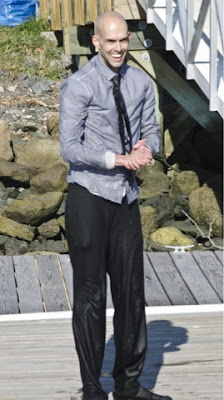



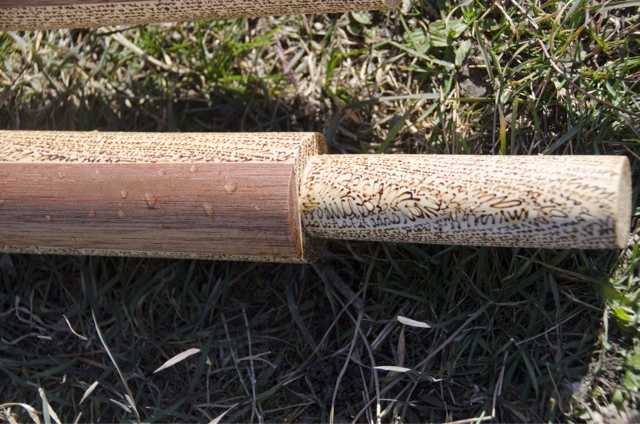
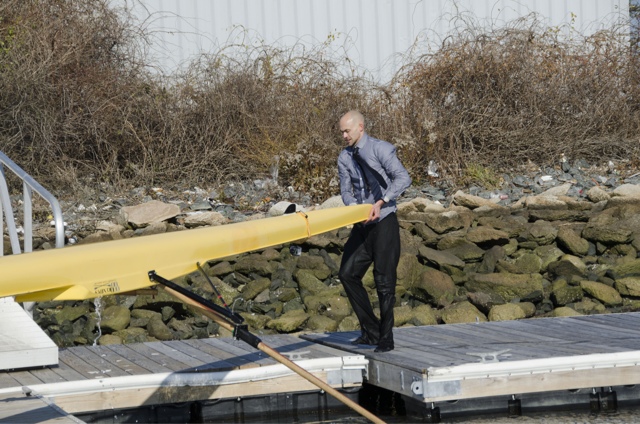



.+2012,+ink+on+Mylar..jpg)


